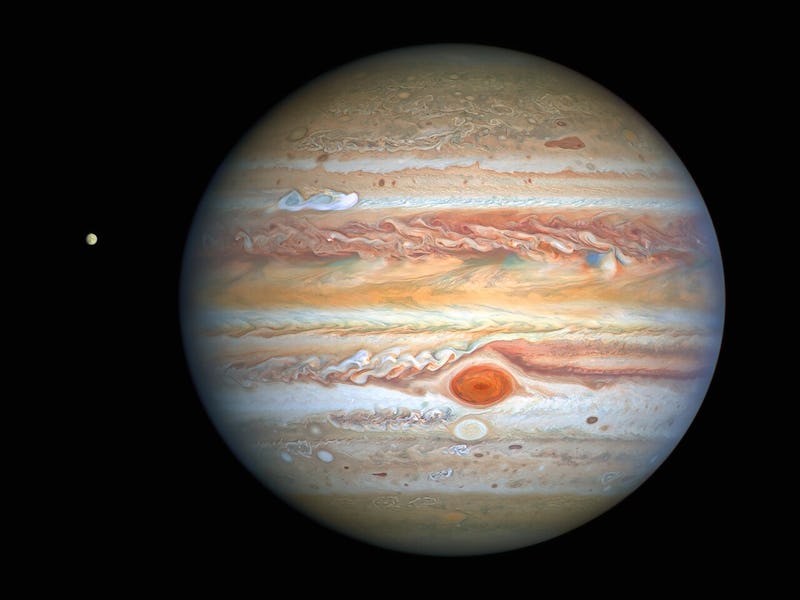Watch: Something strange is happening to Jupiter’s Red Spot
This ancient storm is picking up speed.

For more than 150 years, when humans have looked at Jupiter, they’ve seen a raging vortex larger than the Earth itself swirling with layers of wind and gas.
The Great Red Spot is a high-pressure storm that has been brewing on Jupiter for hundreds of years, and a team of scientists recently discovered that not only does the storm live on, but its winds are also actually picking up speed.
The recent findings were detailed in a study published in the Geophysical Research Letters.
What’s new — After analyzing 11 years of data from the Hubble Space Telescope, astronomers were shocked to discover that the speed of the wind at the outer boundaries of the storm increased by about 8 percent between the years 2009 and 2020.
The wind speeds in the storm’s outer boundary, known as the high-speed ring, exceed 640 kilometers per hour. Meanwhile, the winds from the innermost regions of the storm were moving more slowly. The winds in the two regions move counterclockwise.
“When I initially saw the results, I asked, 'Does this make sense?' No one has ever seen this before," Michael Wong, a researcher at the University of California, Berkeley and lead author of the study, said in a statement.
In this image, the outer boundaries of the storm are marked by the outer green circle with wind speeds exceeding 640 kilometers per hour.
The change in wind speed is less than 2.5 kilometers per hour during one Earth year.
"We're talking about such a small change that if we didn’t have eleven years of Hubble data, we wouldn't know it had happened," Amy Simon, a researcher at NASA's Goddard Space Flight Center in Greenbelt, Maryland and co-author of the study, said in a statement.
Here’s the background — Although the change is small, it is still significant. Despite years of observation, this 400 mile-per-hour anticyclone storm remains largely a mystery to scientists. A lot is still unknown about what fuels the storm, how it maintains its momentum, and the physics that govern it.
In 2017, observations by NASA’s Juno spacecraft found that the root of the Great Red Spot extends 50 to 100 times deeper than the deepest ocean on Earth.
The Great Red Spot has also crushed several rumors of its demise:
- In the late 1880s, the Great Red Spot measured as wide as 35,000 miles, or around four times the diameter of Earth. By the time the Voyager spacecraft made it to the planet Jupiter a century later, the storm appeared to be about twice the width of Earth. This led scientists to debate whether the Great Red Spot was shrinking in size.
- In May 2019, an amateur astronomer spotted something unusual about the Great Red Spot. A blade-like shape seemed to be flaking off from the vortex, which led some to believe that it would soon disintegrate into oblivion. But later observations showed that the Great Red Spot still had centuries more to go.
This latest bit of information about the storm’s wind speeds is another intriguing feature of the Great Red Spot.
“It's an interesting piece of the puzzle that can help us understand what's fueling the Great Red Spot and how it's maintaining its energy," Wong said.
What’s next — NASA’s Juno probe continues to study the giant planet and map its interior structure while taking stunning photos of the world as well. It can provide us perhaps the best vistas of the storm when aligned just right. Monitoring will also continue by the Hubble Space Telescope and the upcoming James Webb Space Telescope.
Two upcoming missions — ESA’s Jupiter Icy Moons Explorer (JUICE) and NASA’s Europa Clipper — will orbit Jupiter while getting unprecedented views of Jupiter’s intriguing moons. It may, in the process, get more than a few good glimpses of the great red spot.
Abstract — We measured the horizontal winds in Jupiter's Great Red Spot (GRS) using data from the WFC3/UVIS instrument on board the Hubble Space Telescope (HST). The data cover 11 epochs from 2009 to 2020. Long-term monotonic trends in size and shape previously noted from the visible cloud appearance are paralleled by changes in the high-speed ring around the vortex. The circularization of the GRS cannot be explained by changes in the horizontal wind shear of the surrounding environment. The velocity fields suggest no long-term trend in the static stability inside or outside the vortex. Instead, the changes are accompanied by a 4%–8% increase in the mean wind speeds of the high-speed ring from 2009 to 2020. Changes in the wind field coincided with the South Equatorial Belt Outbreak storms of 2016– 2017, but not with 2019 "flaking" events involving detachment of red material from the main oval.